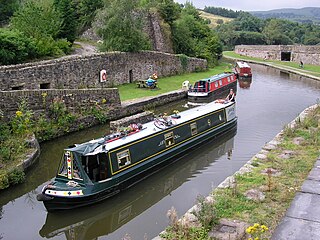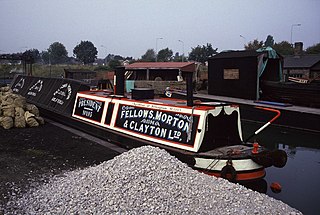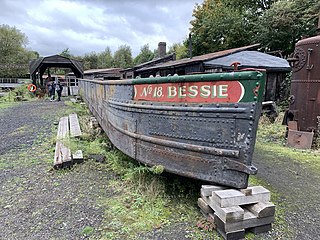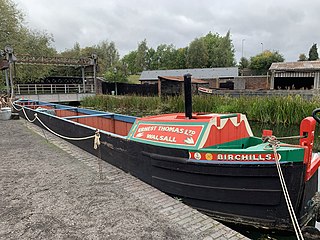
Maritime transport and hydraulic effluvial transport, or more generally waterborne transport, is the transport of people (passengers) or goods (cargo) via waterways. Freight transport by sea has been widely used throughout recorded history. The advent of aviation has diminished the importance of sea travel for passengers, though it is still popular for short trips and pleasure cruises. Transport by water is cheaper than transport by air, despite fluctuating exchange rates and a fee placed on top of freighting charges for carrier companies known as the currency adjustment factor. Maritime transport accounts for roughly 80% of international trade, according to UNCTAD in 2020.

A PT boat was a motor torpedo boat used by the United States Navy in World War II. It was small, fast, and inexpensive to build, valued for its maneuverability and speed but hampered at the beginning of the war by ineffective torpedoes, limited armament, and comparatively fragile construction that limited some of the variants to coastal waters. In the USN they were organized in Motor Torpedo Boat Squadrons (MTBRONs).

A narrowboat is a particular type of canal boat, built to fit the narrow locks of the United Kingdom. The UK's canal system provided a nationwide transport network during the Industrial Revolution, but with the advent of the railways, commercial canal traffic gradually diminished and the last regular long-distance transportation of goods by canal had virtually disappeared by 1970. However, some commercial traffic continued. From the 1970s onward narrowboats were gradually being converted into permanent residences or as holiday lettings. Currently, about 8580 narrowboats are registered as 'permanent homes' on Britain's waterway system and represent a growing alternative community living on semi-permanent moorings or continuously cruising.

The canal network of the United Kingdom played a vital role in the Industrial Revolution. The UK was the first country to develop a nationwide canal network which, at its peak, expanded to nearly 4,000 miles in length. The canals allowed raw materials to be transported to a place of manufacture, and finished goods to be transported to consumers, more quickly and cheaply than by a land based route. The canal network was extensive and included feats of civil engineering such as the Anderton Boat Lift, the Manchester Ship Canal, the Worsley Navigable Levels and the Pontcysyllte Aqueduct.

The Black Country Living Museum is an open-air museum of rebuilt historic buildings in Dudley, West Midlands, England. It is located in the centre of the Black Country, 10 miles west of Birmingham. The museum occupies 105,000 square metres of former industrial land partly reclaimed from a former railway goods yard, disused lime kilns, canal arm and former coal pits.

The canals of the United Kingdom are a major part of the network of inland waterways in the United Kingdom. They have a varied history, from use for irrigation and transport, through becoming the focus of the Industrial Revolution, to today's role of recreational boating. Despite a period of abandonment, today the canal system in the United Kingdom is again increasing in use, with abandoned and derelict canals being reopened, and the construction of some new routes. Canals in England and Wales are maintained by navigation authorities. The biggest navigation authorities are the Canal & River Trust and the Environment Agency, but other canals are managed by companies, local authorities or charitable trusts.

Eureka is a side-wheel paddle steamboat, built in 1890, which is now preserved at the San Francisco Maritime National Historical Park in San Francisco, California. Originally named Ukiah to commemorate the railway's recent extension into the City of Ukiah, the boat was built by the San Francisco and North Pacific Railroad Company at their Tiburon yard. Eureka has been designated a National Historic Landmark and was listed in the National Register of Historic Places on April 24, 1973.

Eppleton Hall is a paddlewheel tugboat built in England in 1914. The only remaining intact example of a Tyne-built paddle tug, and one of only two surviving British-built paddle tugs, she is preserved at the San Francisco Maritime National Historical Park in San Francisco, California.

SS City of Milwaukee is a Great Lakes railroad car ferry that once plied Lake Michigan, often between Muskegon, Michigan and Milwaukee, Wisconsin. She was built in 1931 for the Grand Trunk Milwaukee Car Ferry Company and is the only pre-1940s ship of this type to survive. She now serves as a museum ship, bed and breakfast, and event venue on the waterfront of Manistee Lake in Manistee, Michigan. She was designated a National Historic Landmark in 1990.

SS Milwaukee Clipper, also known as SS Clipper, and formerly as SS Juniata, is a retired passenger ship and automobile ferry that sailed under two configurations and traveled on all of the Great Lakes except Lake Ontario. The vessel is now docked in Muskegon, Michigan.

The harbour defence motor launch (HDML) was a 72 ft (22 m) long British-designed motor vessel used for harbour defence during World War II. Nearly 500 were built by numerous Allied countries during the war.

Luna is a historic tugboat normally berthed in Boston Harbor, Massachusetts. Luna was designed in 1930 by John G. Alden and built by M.M. Davis and Bethlehem Steel. She is listed on the National Register of Historic Places and is a U.S. National Historic Landmark. In 1985, the Luna was designated as a Boston Landmark by the Boston Landmarks Commission.

Fellows Morton & Clayton Ltd was, for much of the early 20th century, the largest and best-known canal transportation company in England. The company was in existence from 1889 to 1947.

President is a historic, steam-powered narrowboat, built in 1909 by Fellows Morton & Clayton (FMC) at their dock at Saltley, Birmingham, England. It is now owned by the Black Country Living Museum, where it is based. President is registered by National Historic Ships as part of the National Historic Fleet.

Bessie is a historic, single ended riveted iron day boat, built in 1895 for the Hartshill Iron Company. It is now owned by the Black Country Living Museum, Dudley, West Midlands, England, where it is based.

Birchills is a historic, ‘Joey’ boat with a small day cabin, built in 1953 by Ernest Thomas of Walsall. Birchills was one of the last wooden day boats made and was used to carry coal to Birchills Power Station and Wolverhampton Power Station. It is the only surviving 'Joey' with a day cabin.
Diamond was built by John Crichton & Co. of Saltney, Chester for Midland and Coast Canal Carrying Company of Wolverhampton. The boat was built in Chester in 1927 and first registered at Wolverhampton in 1928. She was one of six iron boats in the fleet fitted with two cabins for long-distance traffic between the Black Country and the ports on the Mersey Estuary. Having been damaged during an air raid on Birmingham in 1944 she was sold for scrap to Ernest Thomas by Fellows, Morton & Clayton who had by then acquired Midlands and Coast. Rebuilt and renamed ‘Henry’ she carried coal until the 1960s when she was resold to ‘Caggy’ Stevens of Oldbury and renamed ‘Susan’. It is now owned by the Black Country Living Museum, where it is based and can be seen dockside in the Lord Ward's Canal Arm at the Black Country Living Museum in Dudley. Diamond is on the National Historic Ships register.

Kildare is an un-powered butty boat constructed with wrought iron sides and an elm bottom. She was built for Fellows Morton & Clayton around 1913 by Braithwaite & Kirk of West Bromwich to be towed behind a powered craft like President. She is complete with a fully fitted boatman's living cabin and traditional covering cloths over the main hold area.
North Star is a derelict wooden horse-drawn icebreaker built in 1868 and was used to clear a way through the ice when the canals were frozen. She is registered with National Historic Ships UK with certificate no 1963 She was built at Ocker Hill by the Birmingham Canal Navigations Company as North Star. She was then sold in 1904 to the Stourbridge Canal Company where she acquired the name Samson. In 1940 she moved to Walsall where she worked until 1962. In 1967 she was converted to a pleasure boat and kept as such until 1987.

Peacock is a British narrowboat. She was built as a flyboat for Fellows Morton & Clayton (FMC) at Saltley, Birmingham in 1915, as fleet number 102. FMC had been using a fleet of steam fly boats since 1889, but in 1912 introduced motor boats such as Peacock into their fleet. 'Fly' boats work day and night non-stop, and with an all-male crew the cabins were more spartan than those of long distance family crewed boats.



















